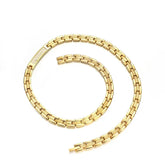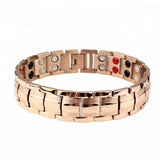8 Easy Ways To Reduce EMF Exposure At Home
In today’s digital world, many of us are searching for easy ways to reduce EMF exposure at home without giving up the technology we rely on. From Wi-Fi routers and smartphones to smart meters and baby monitors, our houses are filled with devices that constantly emit electromagnetic fields (EMFs).
While this invisible radiation often goes unnoticed, studies suggest that long-term exposure may be linked to issues like poor sleep, headaches, and fatigue. The good news? You don’t have to sacrifice modern convenience to live healthier.
With just a few simple adjustments—like choosing wired connections, creating an EMF-free sleep zone, or switching devices to airplane mode—you can enjoy your tech while protecting your family’s well-being.
The Unanswered Question: How Much EMF is Too Much?
It's a question that echoes in the digital age: "What is a safe level of EMF exposure?" For many, the answer feels frustratingly elusive, a murky area where clear scientific consensus seems to dissolve into a collection of conflicting opinions. The truth is, there's no single, universally accepted answer.
If you ask the world's leading experts, you'll find a startling variety of responses, often influenced by their country of origin and the organizations they represent. This isn't a simple case of different scientific interpretations; it's a complex global puzzle.
Perhaps most surprising to many is a fact about the United States: there are currently no federally developed safety standards for wireless radiation exposure that companies or manufacturers must legally adhere to. This leaves a significant void in consumer protection, placing the onus on individuals to navigate this invisible landscape themselves.
This lack of a unified standard is a critical part of the conversation. It's why one person might tell you wireless technology is perfectly safe, while another warns of potential long-term risks. It's a key reason why understanding and taking personal action to reduce your exposure is more important than ever. Instead of waiting for a definitive answer, we're all being asked to become our own best advocates.
Identify Common Sources of EMF in Your Home
Becoming aware of the main culprits is the first step in reducing your overall exposure to wireless radiation sources. Many everyday devices act as household EMF emitters. Common offenders include:
- Wi-Fi routers: Constantly broadcasting wireless signals.
- Smartphones: Especially when in use or searching for a signal.
- Laptops and Tablets: Particularly when connected wirelessly.
- Smart meters: Transmitting data about energy usage.
- Baby monitors: Wireless models emit EMFs near infants.
- Smart TVs: Connected to Wi-Fi for streaming.
- Microwave ovens: Emitting high levels of EMFs during operation.
- Bluetooth devices: Headphones, speakers, and other peripherals.
Understanding where these wireless radiation sources are located in your home allows you to implement targeted reduction strategies.
How to Reduce EMF Exposure at Home?

Here are some tips for reducing EMF exposure in your home:
Keep a Safe Distance from EMF Sources
When it comes to EMF exposure, distance is your friend. The intensity of radiation decreases significantly as you move further away from the source. Consider these practical examples to increase your distance from household EMF emitters:
- Avoid keeping your smartphone in your pocket for extended periods. Opt for a bag or place it further away on a desk. check out How Far Away Should Your Cell Phone Be When You Sleep?
- Try not to sit or work directly next to your Wi-Fi router. If possible, position it in a less frequently occupied area.
- Refrain from placing your laptop directly on your lap. Use a lap desk or a physical barrier to create distance.
- Be mindful of the proximity effect with all wireless devices and try to maintain a reasonable gap whenever feasible.
While there are no universally agreed-upon EMF exposure limits for non-ionizing radiation, practicing mindful distancing can help lower your overall radiation intensity. You can read How to Protect Yourself from EMF Radiation?
Switch to Wired Connections When Possible
One of the most effective ways to reduce wireless radiation exposure is to embrace good old-fashioned cables. Where possible, replace wireless connections with hardwired alternatives:
- Connect your computers and smart TVs to the internet using Ethernet cables instead of relying solely on Wi-Fi. A wired internet connection offers a stable and often faster connection without the continuous RF emissions.
- Consider using a corded phone (VOIP landline) instead of cordless DECT phones, which constantly emit radiation.
- Opt for wired gaming controllers and headphones over their Bluetooth counterparts.
Transitioning to hardwired technology can significantly decrease the amount of wireless EMFs circulating in your home.
Use Airplane Mode and Power Down Devices
Take advantage of built-in features and simple power controls to minimize EMF emissions:
- Enable airplane/flight mode on your smartphone and tablet whenever you don't need wireless connectivity. This turns off the device's antennas, halting the transmission of cellular and Wi-Fi signals.
- Get into the habit of powering off your Wi-Fi router, especially during sleep hours. There's no need for it to be broadcasting signals while everyone is asleep.
- Turn off Bluetooth on your devices when not actively in use. Many devices constantly perform a digital handshake, emitting RF signals even when not actively paired.
Reducing the amount of time your devices are actively transmitting wireless signals can lead to a noticeable decrease in overall EMF exposure at home. Visit a complete blog related to 5 Proven Ways to Cut EMF Exposure on Long Flights & Stay Safe
Create a Low-EMF Sleep Environment
Since we spend a significant portion of our time sleeping, creating a low-EMF sleep environment is crucial for rest and potential long-term health:
- Remove all electronic devices, including smartphones, tablets, and laptops, from your bedroom. Keep them in another room while you sleep.
- Avoid charging your devices on your nightstand or near your bed. Choose a charging station in a different area of your home.
- Opt for a battery-powered alarm clock instead of using your phone as an alarm.
Minimizing EMFs in your bedroom can contribute to better sleep quality by reducing potential sleep disruption and the impact on your circadian rhythm. Additionally, reducing blue light exposure from screens before bed further enhances sleep hygiene. Check this informative post related to How to Protect Yourself from EMF Radiation?
Reduce EMF Exposure from Your Car & Travel
EMF exposure isn't limited to your home. Your car and travel environments can also be sources:
- Turn off Bluetooth and Wi-Fi on your phone while driving if you don't need them. Your car's systems may also have their own wireless functionalities.
- Download movies, music, and maps before long trips to avoid constant streaming and signal searching.
- Use a wired GPS navigation device instead of relying solely on your smartphone's wireless connection.
Being mindful of car EMF exposure and practicing travel EMF safety can contribute to a lower overall exposure.
Protect Children and Pregnant Women
Certain populations may be more susceptible to the effects of EMFs. Exercise extra caution to protect children and pregnant women:
- Children's thinner skulls and developing bodies may lead to a higher absorption rate of EMF radiation compared to adults. Limit their exposure to wireless devices and encourage wired alternatives for entertainment and learning. Avoid giving young children smartphones or tablets for prolonged use.
- Pregnant women may want to be particularly mindful of EMF exposure. Avoid carrying your phone near your abdomen and consider using speakerphone or wired headphones for calls.
Taking these extra precautions can help minimize potential child EMF exposure and prenatal EMF risk. Check out the informative guide about Why Kids Are More Vulnerable to EMF Radiation? Practical Tips. and EMF and Pregnancy Safety: Research and Precautions.
Consider EMF Shielding Products for Extra Protection
For those seeking an additional layer of protection, various EMF shielding products are available. While these don't eliminate EMFs entirely, they are designed to reduce exposure:
- EMF blocking curtains: Can help reduce incoming radiation from external sources like cell towers.
- Router guards: Enclosures designed to contain some of the Wi-Fi router's emissions.
- Faraday bags: Useful for temporarily blocking signals to devices like phones and laptops.
- Shielding fabrics: Can be used in clothing or blankets to provide a barrier against EMFs.
Explore our range of EMF protection products to find solutions that fit your needs and help create a safer home environment. Remember that these products work to reduce exposure and should be used as part of a broader strategy. You can check our complete blog post about What Materials Can Block EMF Radiation? A Comprehensive Guide to gain more knowledge.
Limit Screen Time and Smart Tech Use
Beyond specific devices, our overall reliance on wireless gadgets contributes to our total EMF exposure. Consider these habits:
- Take regular breaks from screens throughout the day.
- Reduce your overall reliance on wireless gadgets where possible.
- Choose non-wireless options for tasks that don't strictly require a wireless connection.
Practicing digital wellness and being mindful of our tech habits can have a positive impact on our EMF exposure and overall well-being.
EMF Protection Bonus Tip – Check Your Smart Meter
Smart meters, while convenient for utility companies, continuously transmit data wirelessly. If you have concerns:
- Inquire with your utility provider about the possibility of replacing your smart meter with an older analog electric meter, although this may not always be an option.
- Consider using shielding covers specifically designed for smart meters to reduce potential radiation emissions.
Addressing smart meter radiation can be another step in minimizing your home's overall EMF footprint.
Final Thoughts
Reducing EMF exposure at home is about building awareness of the sources around us and making small, consistent daily changes. By implementing these practical tips and considering safer technology choices, you can create a healthier and more balanced living environment.
Ready to take the next step in protecting your home from EMFs? Explore our curated selection of EMF protection products, including shielding solutions and wired alternatives, to make your home a safer and healthier sanctuary.
Resources:
- Stein, Y., & Udasin, I. G. (2020). Electromagnetic hypersensitivity (EHS, microwave syndrome) - Review of mechanisms. Environmental research, 186, 109445. https://doi.org/10.1016/j.envres.2020.109445
- Pineault, N. (2017). The non-tinfoil guide to emfs: How to fix our stupid use of Technology. Nicolas Pineault.
- Asghari, A., Khaki, A. A., Rajabzadeh, A., & Khaki, A. (2016). A review on Electromagnetic fields (EMFs) and the reproductive system. Electronic physician, 8(7), 2655–2662. https://doi.org/10.19082/2655
- Staff, health enews. (2021, September 27). Do 6-year-olds need cell phones? health enews. Retrieved December 26, 2022, from https://www.ahchealthenews.com/2021/09/28/does-your-6-year-old-need-a-cell-phone/
- IARC Working Group on the Evaluation of Carcinogenic Risks to Humans. Non-Ionizing Radiation, Part 2: Radiofrequency Electromagnetic Fields. Lyon (FR): International Agency for Research on Cancer; 2013. (IARC Monographs on the Evaluation of Carcinogenic Risks to Humans, No. 102.) 1. Exposure Data. Available from: https://www.ncbi.nlm.nih.gov/books/NBK304634/
- Kriebel, D., Tickner, J., Epstein, P., Lemons, J., Levins, R., Loechler, E. L., Quinn, M., Rudel, R., Schettler, T., & Stoto, M. (2001). The precautionary principle in environmental science. Environmental health perspectives, 109(9), 871–876. https://doi.org/10.1289/ehp.01109871






